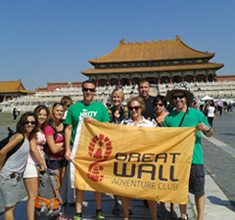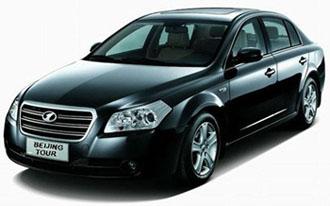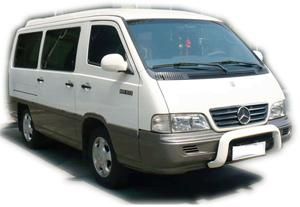Beijing Five-day
Private Tour
|

How much is this private tour?
(average per person)
| # of Head |
USD |
| 1 |
1199 |
| 2 |
769 |
| 3 |
689 |
| 4-5 |
669 |
| 6-9 |
619 |
| 10+ |
569 |
Kids under 3 are free;
5% for aged between 3 and 12.
GUARANTEED NO
SHOPPING STOP!
SIMPLY SIGHTSEEING!
|
|
Beijing
Five-day Private Tour
Summer Palace, Tian’anmen Square,
Forbidden City/Imperial Palace
Great Wall at Badaling or Mutianyu, Ming Tombs (Dingling + Shenlu)
Beijing Zoo, Lhama Temple and Hutong Tour
Beijing Olympic Green, Temple of Heaven and the Hongqiao Market |
|
| |
TOUR ITINERARY
A packed 5 days of the best in
Chinese history and culture!
|
 |
Tour
code:
GWA-BJ-501 |
|
Day 1:
After meeting you at the airport, we will drive by private
minivan to the Summer Palace.
We will meet you at Peking International Airport, and from
their drive by private mini bus to the Summer Palace. Having
the largest royal park and being well preserved, the Summer
Palace is ranked amongst the most noted and classical
gardens of the world. In 1998, UNESCO listed it as one of
the World Heritage Sites. Like most of the gardens of
Beijing, it could not elude the rampages of the Anglo-French
allied force of 1860 and was destroyed by fire. In 1888,
Empress Dowager Cixi embezzled navy funds to reconstruct it
for her own benefit, changing its name to Summer Palace (Yiheyuan).
She spent most of her later years there, dealing with state
affairs and entertaining.
Highlights not to be missed are climbing Longevity Hill,
viewing the Empress Dowager Cixi’s extravagant Marble Boat,
and talking a walk down Suzhou jie, a canal meant to
resemble the beautiful river city of Suzhou.
After a refreshing lunch we will head to Tian’anmen Square.
The largest public square in the world at 440,000 square
meters, Tian’anmen Square has been the site of the most
important developments in China’s modern political and
cultural history. It was the stage for the May 4th movement
(where in 1919 Chinese students protested the transfer of
Shandong province from Germany to Japan), the protests
following the death of premier Zhou Enlai in 1976, and of
course the political turmoil of 1989. The Monument to the
People’s Heroes marks the center of the square, a ten-story
obelisk built in dedication to those who died fighting for
Chinese Revolution. The square is flanked on the east by the
National Museum of China (set to reopen in late 2010), on
the west by the Great Hall of People (home of china’s
legislative bodies), to the south by the Chairman Mao
Memorial Hall (where his body lies in a crystal coffin), and
of course to the north by the Gate of Heavenly Peace, with
its distinctive portrait of Mao Zedong. The Gate of Heavenly
Peace is the official symbol of the People’s Republic of
China.
After walking across the square we will enter the Forbidden
City, the world’s largest surviving palace complex and the
former home of the emperors of the Ming and Qing Dynasty.
The Forbidden City is one of the greatest attractions in the
world, and once you enter its confines it is easy to see
why. Built by the third Ming emperor between 1406-1422, the
Forbidden City served as the official residence to the
Emperor of China until the last emperor, Puyi, was forced to
evacuate in 1924. Afterwards, the Forbidden City was
officially known as the Palace Museum. The Forbidden City is
divided into two parts. The southern section, or the Outer
Court, was where the emperor exercised his supreme power
over the nation. The northern section, or the Inner Court
was where he lived with his royal family. Consisting of 980
buildings with 8,707 bays of rooms, the Forbidden City is
the best example of classical Chinese architecture in the
world, and is one of the greatest wonders of the world.
After exploring the Forbidden City we will take you to your
hotel for the night. |
Day 2:
Today’s sights involves two UNESCO World Heritage
Sites, and a chance to see a little of the Beijing
countryside. After meeting you at your hotel in the morning
we will drive to the Great Wall at Badaling. Badaling was
the first section of the Great Wall to be opened to the
public in 1957, and is therefore the best known among
visitors. Badaling was the site of U.S. President’s Richard
Nixon’s visit to the Great Wall on his historic trip to
China, and is a popular choice for celebrities, foreign
dignitaries and leaders (U.S. President Obama visited
Badaling in November of 2009). Badaling also offers
incredible views of the wall winding and twisting along the
hills. After a delicious lunch we will make the short
journey by minibus to the Ming Tombs.
The Ming Tombs, about 50 km/31 miles from Beijing, are where
13 emperors of the Ming Dynasty (1368-1644) are buried. This
site was carefully chosen for its feng shui principles by
the third Ming emperor Yongle (who also moved the capital
from Nanjing to Beijing and began construction on the
Forbidden City). The tomb we will visit, Dingling, is the
tomb of the Wanli Emperor. It is the only one of the Ming
Dynasty Tombs to have been excavated. It also remains the
only imperial tomb to have been excavated since the founding
of the People's Republic of China. After viewing the tombs,
we will head to the “Shenlu”, or the Spirit Way. The Spirit
Way leads into the complex, lined with statues of guardian
animals and officials, with a front gate consisting of a
three-arches, painted red, and called the "Great Red Gate".
The Spirit Way, or Sacred Way, starts with a huge stone
memorial archway lying at the front of the area. Constructed
in 1540, during the Ming Dynasty, this archway is one of the
biggest stone archways in China today.
After walking the Spirit Way we will take you back to your
hotel, completing the day’s travels.
Note: Because Badaling is the most well known section of the
Great Wall, it can become quite crowded. If you prefer, we
can take you to Mutianyu, a restored section of the wall
that is not as crowded as Badaling. Please indicate to us
what you’d like to do when booking. |
Day 3:
After picking you up at your hotel in the morning, we will
head straight to the Beijing Zoo. Unlike other zoos in
China, the Beijing Zoo has the distinct look of a classical
Chinese garden. Initially an imperial manor during the Ming
Dynasty, the grounds was converted into a zoo in 1908 with
the original name being The Ten Thousand Animal Garden. The
Beijing Zoo exhibits the wild and rare animals of China.
Outside of traveling to Sichuan, this is the best place in
China to view the Giant Panda. The zoo also includes a
monkey hall, lion hall, and tiger hall. Altogether there are
more than 30 large halls exhibiting animals.
After visiting the zoo we will go to visit the Lhama Temple.
Other than the temples in Tibet this is the best Buddhist
temple in China. Work on the Lhama Temple originally began
in 1694 during the Qing dynasty. It served as an official
residence for court eunuchs. It was then converted into the
home of the Prince Yong, a son of the Kangxi Emperor and
himself the future Yongzheng Emperor. It was converted into
a lamasery after his ascension to the throne in 1722. Today
the Lhama Temple still functions as a monastery and temple
of the Geluk School of Tibetan Buddhism. Walking through the
temple your senses will be enveloped by the incenses and the
chanting of the visiting monks and other followers. The rear
Pavilion of Ten Thousand Happinesses features a 26m tall
statue of the Maitreya Buddha cared from a single piece of
white sandalwood. It is one of three artworks in the Lhama
Temple that were included in the Guiness Book of World
Records, and it is not to be missed on your visit.
After visiting the Lhama Temple we will embark on a rickshaw
tour of Beijing hutongs. Hutongs are courtyard homes grouped
together around narrow alleys, and served as the lifeline
and center of everyday life in old Beijing. The hutongs were
a critical component in the development and evolution of
Beijing folklore and culture. Going on this hutong tour, you
will feel like you have traveled back in time to a far
different China, one where there was still an emperor
sitting in the Forbidden City, and where there was still
enough time to enjoy the simple pleasures of common life. |
Day 4:
After a morning pickup from your hotel, we will
make the drive to the Olympic Green. The Olympic Green was
the center of the event that captivated the world for two
weeks in August of 2008, and is where a majority of the
Olympic events took place. The highlights include the Bird’s
Nest (officially known as the Beijing National stadium) and
the Water Cube (the Beijing National Aquatics Center). The
stadium gets its nickname from its outward design, which
originated from the study of Chinese ceramics, implementing
steel beams in order to hide supports for the retractable
roof, thus giving the stadium the appearance of a "Bird's
nest". The Bird’s Nest hosted the Opening and Closing
Ceremonies, athletic events, and football final of the 2008
Summer Olympics, from 8 August to 24 August 2008. Since the
Olympic end, the Bird’s Nest has been used to host events
ranging from opera to a ski park.
The site of Michael Phelps’ Olympic triumph, the Water Cube
design combines modern technologies with Chinese traditional
values. In tradition, Chinese conceptualized a square Earth
and a round Heaven, and this formed the design’s central
theme. Moreover, the cube shape dominates ancient urban
buildings. The National Aquatics Center's design is of
traditional style to meet all its functional requirements.
The National Aquatics Center looks like a huge blue box,
from which it takes its nickname: the Water Cube. The Water
Cube is blue in order to reflect sunlight. The National
Aquatics Center shines in the sunlight like a pearl in
water. From the inside of the National Aquatics Center, you
may discover that the pneumatic cushions of all sizes are
just like sea bubbles.
After touring and visiting the Olympic Green we will make
our way to the Temple of Heaven park. The complex was
visited by the Emperors of the Ming and Qing dynasties for
annual ceremonies of prayer to Heaven for good harvest. The
Temple of Heaven park is best known for the Hall of Prayer
for Good Harvests, an iconic building famed for its
magnificent triple-gabled circular roof. You will also have
an opportunity to walk the same imperial walkway that the
same emperors walked hundreds of years ago in their holy
rites. You will also see Beijing’s senior citizens using the
park grounds for everything from tai chi and ballroom
dancing to bullwhip practice!
To cap off the tour, we will take a short walk just outside
the east gate of the Temple of Heaven Park to the Honngqiao
Pearl Market. The Hongqiao Pearl Market is one of the
best-known pearl markets in the world, and you are sure to
find a bargain here. More than 1,000,000 visitors come to
Hongqiao Market to buy pearls yearly. Even the former
British Prime Minister Margaret Thatcher and current U.S.
Secretary of State Hillary Clinton has been to Hongqiao
Market to try to pick up the latest beautiful pearls. Apart
from pearls, the market also offers seafood, digital
products and silk. Since it is a market, bargaining is the
norm, so if you need some assistance, our guide will be sure
to give you a hand, and in return you’ll get some great
swag! After the strolling through Hungrier we will take you
back to your hotel.
|
Day 5:
Today is a free day today, so you are welcome to do
whatever you desire. However, this tour includes free
drop-off at the airport, so please take advantage of it.
After these 5 days in Beijing, you will understand what
makes the city one of the greatest in the world, and the
memories and sights (as well as the photographs!) will be
with you for the rest of your life! |
Tour Inclusions:
1. Professional local guide
& driver;
2. Private air-conditioned
car or van for transportation;
3. Admission of the first
gate.
Tour exclusions:
1. Tip of the guide
and driver;
2. Personal costs;
3. Meals.
 See
other Beijing touring programs. See
other Beijing touring programs.
 
YOUR SAFETY IS IMPORTANT!
At the Great Wall Adventure Club, we only use new and luxury vehicles
for your safety and comfortable journey!
|
|

